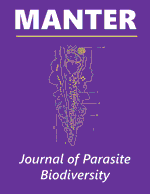Parasitology, Harold W. Manter Laboratory of

MANTER: Journal of Parasite Biodiversity
Date of this Version
1-17-2020
Document Type
Article
Citation
MANTER: Journal of Parasite Biodiversity (January 17, 2020) number 12
doi: 10.32873/unl.dc.manter12
Abstract
A survey of ectoparasites associated with bats collected along an elevational transect in the Manú Biosphere Reserve, Peru, includes specimens of two species of an unusual and rarely collected family of parasitic mites, the Spelaeorhynchidae Oudemans, and reveals information on the natural occurrence of these infections. In lowland rainforest (450–1,000 m) along the Rio Alto Madre de Dios, Spelaeorhynchus soaresi Peracchi was recorded exclusively infecting two species of frugivorous Carollia, C. brevicauda and C. perspicillata. At higher elevations in the mountains and cloud forests, Spelaeorhynchus praecursor Neumann exclusively infected two species of nectarivorous Anoura, A. cultrata and A. geoffroyi. The consistency of both altitudinal and host distributional limits between sampling periods suggests that the true focus of infection may be sustained in certain habituated, long-term roosting sites. This valuable spelaeorhynchid survey collection (slides and vials) is available for further study at the following repositories: the Harold W. Manter Laboratory of Parasitology, University of Nebraska–Lincoln, and the Field Museum of Natural History, Chicago.


Comments
Copyright © 2020, Gettinger, Epperson, Hermasillo, and Gardner
License: CC BY-NC-SA 4.0 International
The archive of record for nomenclatural acts in this journal is the Internet Archive